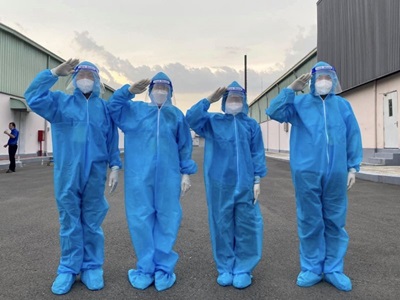MEDICAL PROTECTIVE CLOTHING
I. What is Medical Protective Clothing?
Medical protective clothing is specially designed attire that serves as a crucial barrier to prevent the spread of diseases. By creating a physical shield, it stops body fluids containing harmful viruses from penetrating and infecting the wearer, especially through vulnerable pathways such as the respiratory system. Commonly used in high-risk environments, this clothing is often single-use to ensure optimal safety for medical personnel, patients, and others exposed to hazardous conditions.
II. What Does Medical Protective Clothing Include?
Medical protective clothing is not merely work attire but an essential defense mechanism for those in the medical field. A complete set of medical protective clothing typically includes several components designed to safeguard the wearer comprehensively:
1. Structure of Medical Protective Clothing
The configuration of protective clothing is straightforward, often comprising a jumpsuit, hood, gloves, footwear, and a mask. While one-piece jumpsuits are popular, variations such as separate tops and trousers, gowns, or hooded suits are also in use.
Two main types of protective clothing sets are widely adopted:
■ 4-piece protective set: Includes a hat, shirt, pants (or jumpsuit with hood), and shoes, all crafted from non-woven fabric.
■ 7-piece protective set: In addition to the 4-piece components, this set includes goggles or a face shield, medical gloves, and a medical mask for enhanced protection.
2. Materials Used in Protective Clothing
Protective clothing is made from lightweight yet durable fabrics resistant to tearing and damage. These materials are designed to allow air circulation, ensuring comfort during extended wear. Additionally, the fabric can block harmful substances like chemicals and acids, making it indispensable in high-risk environments. Special fibers used in these garments help prevent bacterial transmission, with some fabrics featuring anti-static properties for added safety.
III. Why Is Medical Protective Gear Necessary?
In a medical environment, professionals face daily exposure to hazardous chemicals, infectious bacteria, and dangerous pathogens. Protective clothing acts as a shield, safeguarding their health and wellbeing. High-quality protective gear instills confidence in medical personnel, enabling them to focus on treating and caring for patients effectively. Feeling secure and well-protected allows them to perform their duties with greater precision and efficiency, ultimately enhancing patient outcomes.
IV. Popular Fabrics for Medical Protective Clothing
The choice of fabric is critical, impacting comfort, durability, and the ability to block harmful agents. Below are some widely used materials:
1. Korean Pangrim Fabric
Known for excellent sweat absorption and a lightweight feel, Pangrim fabric provides comfort and durability, meeting stringent quality standards.
2. American Lon Fabric
Featuring high thread density and vibrant colors, this fabric is ideal for sewing medical coats and uniforms, though it has limited color variety.
3. Kate Ford Fabric
A soft, breathable material, Kate Ford fabric offers a comfortable fit for hospital uniforms but may develop pilling over time.
4. Kaki Elastic Fabric
Durable, non-pilling, and with moderate thickness, this fabric is perfect for sewing uniforms for medical personnel and patients alike.
V. Common Applications of Medical Protective Clothing
Disposable medical protective clothing is a vital resource in healthcare, particularly during global health crises like the COVID-19 pandemic. Its uses extend beyond hospitals, including:
🗹 Ensuring safety in specialized experiments and product testing.
🗹 Maintaining hygiene in food processing facilities and clean rooms.
🗹 Safeguarding workers exposed to sterilization processes and radiation.
🗹 Preventing infection in medical facilities, isolation zones, and inspection stations.
🗹 Providing personal protection in public spaces and manufacturing environments.
🗹 Supporting epidemic prevention efforts at checkpoints and inspection sites.
By adhering to WHO standards, medical protective clothing continues to be a cornerstone of safety, helping professionals and individuals navigate high-risk environments securely and efficiently.








